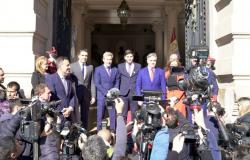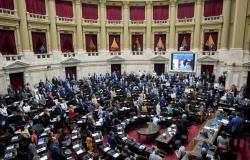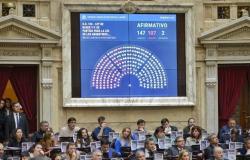Monday, June 10, 2024, 17:23
From telegraph poles to fiber optics, communications have undergone spectacular changes that decisively altered our cultural and social behavior. A particularly dizzying journey in the last hundred years, the same ones that Telefónica has completed, a company that has invited a handful of creators from very diverse disciplines to interact with pieces from its archives and redefine its technological heritage.
The result is ‘Looks that communicate’, a free exhibition that until January 25th exhibits six installations by artists who have chosen iconic objects from the history of telecommunications for their installations in the Telefónica Foundation room in Madrid. There are telephones, telegraph poles, deliverymen, copper cables, photos, films and recordings from different periods in which history and technology merge with the artistic possibilities of light, sound, color and image.
Installation of Pep Gatell, co-founder of the Fura dels Baus.
M.L.
Telefónica has a legacy of more than 85,000 pieces, some of which these creators, who have become occasional telecommunications archaeologists, have worked with. Its installations are not incorporated, at the moment, into the Telefónica Foundation collection.
The pieces are signed by figures such as the multidisciplinary artist Eugènia Balcells, the experimental collective Cabosanroque, the visual artist Daniel Canogar, the theater company La Fura dels Baus-Pep Gatell, the filmmaker Nuria Giménez and the multifaceted and pioneering Isidoro Valcárcel Medina. They all connect the past with the modified present, pieces related to the centuries-old history of today’s multinational.
Pioneer
Starting at the end, the exhibition closes with ‘Telephone Conversations’, a sound piece from 1973 by the award-winning conceptual artist Isidoro Valcárcel Medina. “Professional of ideas”, as he describes himself, National Prize for Plastic Arts (2007) and Velázquez Prize (2015), more than half a century ago he spoke to 80 unknown interlocutors chosen at random to tell them that a new telephone had just been installed and offer them your number for whatever they like. Many respond with shock, disbelief and incomprehension. Others with curiosity and confidence, willing to write down the number and play the game of the unclassifiable artist.
Installation by Isidoro Valcárcel Media.
Telefónica Foundation
A forest of telephone poles, old tools and photos open the route with ‘C0MUNIC4ND0’, a piece by Pep Gatell, co-founder and artistic director of La Fura dels Baus. In three episodes, through anonymous faces and very diverse objects, he illustrates the technological feat that made voice communication possible in the 20th century. He uses images from photographers Alfonso and Marín, who documented the deployment of the telephone lines. It plays with the imposing shortwave transmitter that between 1927 and 1968 allowed communication with America, and with a section of the Rotary, the machines that for 70 years automatically connected two telephone lines.
Eugènia Balcells brings together scientific curiosity and artistic will in ‘The Conductive Thread’ through the copper cable, one of the first metals used by humans. For 150 years, and until the arrival of fiber optics, it was the pillar of communication networks. Balcells weaves a network of fabrics that recalls the types of nodes and communication networks. She uses cable, sound and light to evoke with her sculptural forms a hypnotic aesthetic experience that emulates the journey of voice waves through space and how the millions of kilometers of cable deployed since 1924 structured and connected the territory.
Another aspect of the installation of the co-founder of La Fura dels Baus.
M.L.
Laia Torrents and Roger Aixut, members of Cabosanroque, explore the performative capacities of sound. In ‘Politonos’ they focus on the telephone, the company’s icon, creating a kind of sculpture or sound topography with about 250 terminals from various eras. A central object in the home and office, a milestone of industrial design and popular culture, ‘Politonos’ testifies to the changes in the device before the emergence of the mobile phone and the transition from the circular dial to buttons and the digital universe.
Neural network
In ‘Intervalos’ Daniel Canogar recovers a fragment of a gigantic delivery man. An essential tool for telecommunications, it was a framework that supported the dense tangle of cables that allowed the circulation of voice and data. The installation’s cables seem to come to life with light pulses. Canogar turns the obsolete system into a living entity that evokes the neural pulses that govern our brain. The equipment and cables in his piece come from the Pacífico telephone exchange, a space of more than 3,000 square meters built in the 1950s that managed communications in the eastern area of the center of Madrid.
Daniel Canogar before his installation, ‘Intrevalos’.
M.L.
In ‘Dialogues in Time’ Nuria Giménez shows in five audiovisual diptychs the evolution of the company and the country over a century through short films that since 1924 show the dizzying deployment of telecommunications. Mixed with cinema, television and advertising, it offers the changing social portrait of an entire era captured in programs, newscasts, films or advertisements as legendary as that of ‘Matildes’ or milestones such as ‘The Cabin’, both starring José Luis López Vázquez.
€2/month for 4 months
Are you already a subscriber? Log in





